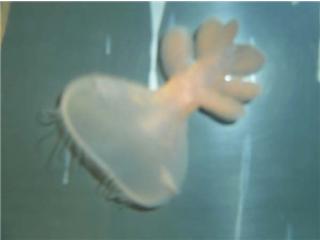Melibe leonina
From ize
| Taxonomy | |
|---|---|
| Kingdom: Animalia | |
| Phylum: Mollusca | |
| Class: Gastropoda | |
| Order: Opisthobranchia | |
| Suborder: Nudibranchia | |
| Family: Tethydidae | |
| Genus: Melibe | |
| Species: M. lionina (Gould 1852) |
Contents |
Common Names
Hooded Nudibranch, Lion Nudibranch
Size
Up to 102 mm long, 25 mm wide and 51 mm across expanded oral hood
Range
West coast of North America from Alaska to Baja California
Habitat
Found on eel grass and other seaweeds near low tide and below and in kelp beds in deeper water.
Description
Body is translucent and usually colorless to pale yellow or green with opaque brown hepatic diverticula. Large expandable oral hood, fringed with sensory tentacles, which it opens and throws forward to catch food. Single pair of rhinophore on hood are rounded and earlike. 4-6 pairs of flat paddle shaped cerata run along its dorsum in two rows. Melibe leonina exudes a sweet fruity aroma when removed from the water or when numerous individuals are kept together in captivity.
Diet
Melibe leonina are carnivorous and hunt for food, while attached to grasses, by extending their oral hood out and downward like a net. When the ventral surface of the hood contacts a small animal, the hood rapidly closes and the fringing tentacles overlap, holding in the prey then forcing the whole animal into the mouth. Prey include amphipods, copepods, mysids, other small crustaceans, small mollusks, small jellyfish and ctenophores, larvae of other invertebrates and in some cases small fish
Reproduction
Like most other sea slugs, Melibe leonina are hermaphrodites. They appear to live about one year, reciprocally fertilize one another, lay their eggs and die. Eggs are attached to kelp and eelgrass in long, wide yellow or cream-colored ribbons which form tight coils or wavy folds.
Predation
Predators may include fish, kelp dwelling crabs and sea stars, but when disturbed Melibe leonina have the ability to autotomize (shed) their cerata. This will hopefully lead the would-be attacker away as the discarded appendages float off or at least cause a distraction long enough to make an escape. When harassed or dislodged, Melibe leonina are capable of swimming using rhythmic lateral-bending movements, sometimes traveling long distances across open water. The upside-down, side-to-side thrashing motion may look awkward, but in fact is a complex series of movements which has been studied extensively.
Works Cited
Behrens, Dave. "Melibe Leonina." The Slug Site. Sept. 1999. 15 May 2008 <http://slugsite.us/bow/nudwk188.htm>.
Meinkoth, Norman A. National Audubon Society Field Guide to North American Seashore Creatures. New York: Alfred a Knopf, Inc., 1981. 531-532.
Various. "The Sea Slug Forum - Melibe Leonina." The Sea Slug Forum. 15 May 2008 <http://www.seaslugforum.net/showall.cfm?base=melileon>.
Watson Iii, Winsor H., Kaddee A. Lawrence, and James M. Newcomb. "Neuroethology of Melibe Leonina Swimming Behavior." Oxfordjournals.Org. 2001. Zoology Department & Center for Marine Biology, University of New Hampshire, Durham, New Hampshire 03824, and Friday Harbor Laboratory, University of Washington, Friday Harbor, Washington 98250. 15 May 2008 <http://icb.oxfordjournals.org/cgi/content/full/41/4/1026>.

